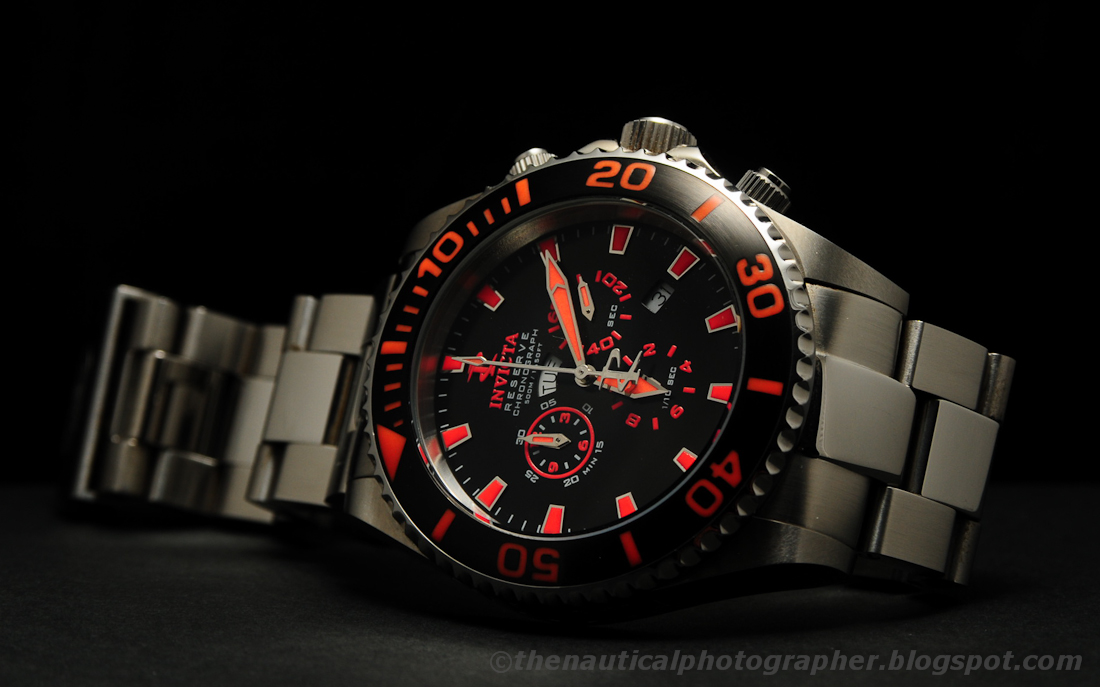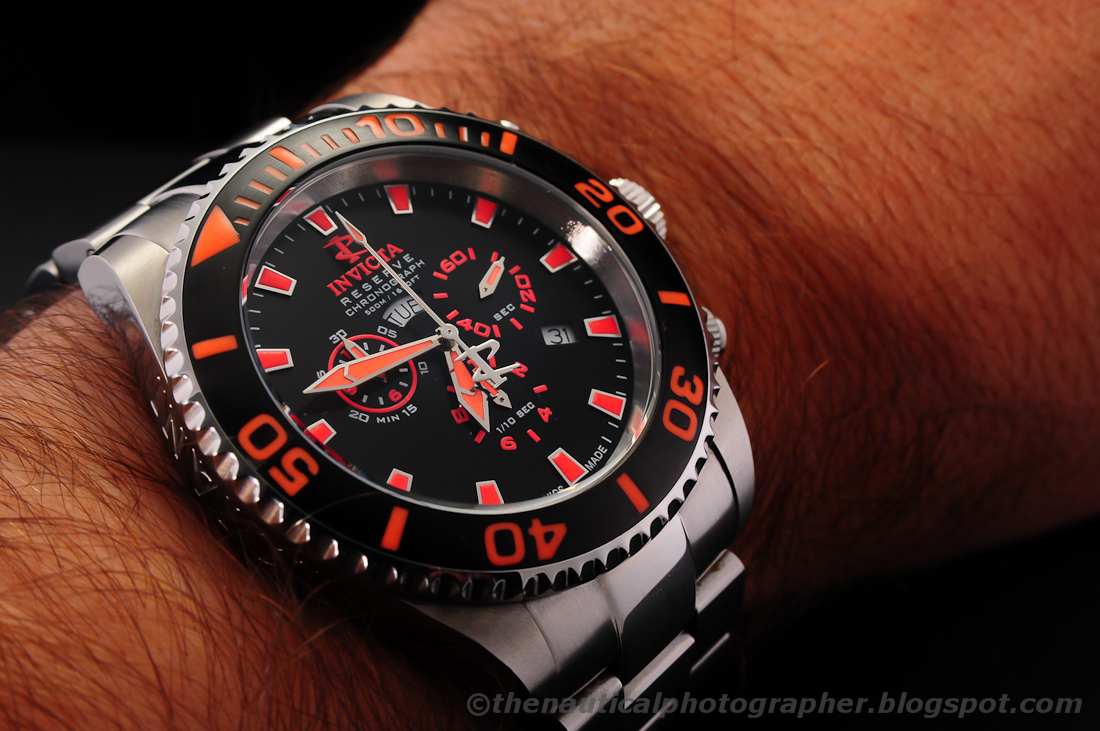First of all let's understand one thing. This modest review is not about some Swiss artisanal extravaganza costing dozens or, sometimes, hundreds of thousands of Euros. It's just my two cents worth about a - my relative opinion - nice looking and cheap watch, which happens to have the hypnotic letters "Swiss Made" engraved on the dial.
Amongst the watch lovers, the brand Invicta is prone to be absent of consensus: you either love it or hate it.
The plain fact is that Invicta watches are just machines. Built to do a work, which is: telling you the time.
Similarly to the automotive industry, where the cars are machines constructed to provide you a service - taking you from point A to point B, in a fastest and safest way - also in the world of watchmaking you can choose between Ferraris and Fiats to do the simple job of telling you the time. If you swim in money or if watches are you lifelong passion, by all means go hog wild, grab your credit card and go on, buy that Swiss beauty that you have been courtshiping for the last couple of years. After all, it's not only a watch... it's a work of art. And it's also an investment (so they say!). Two things are certain, we all know, after that acquisition: your bank account will noticeably diminish and your self-esteem will increase. However, as any Ferrari owner will tell you, owning the damn thing is only part of the problem. Maintaining it is also a pain in the...
That's why a lot of people (even some rich, cheapskate, ones) choose the Fiats over the Ferraris. Because they are cheaper. And do exactly the same thing. For the rest of us, the working class heroes, navigating through life on the verge of bankruptcy, the dilemma is a different one: you either buy the Fiat or you forget that cheap watches nonsense and use you cell phone to tell you the time.
Well, not so fast. Thanks to the capitalistic(!?) regime we are living in, the poor are also allowed to have exclusive toys, without the price tag of the real things.
Remember the pocket-rockets? These are car versions, within a particular model, that are equipped with more powerful engines and better dynamic behaviour than their commuting counterparts. They are the "sports" version of that model, and therefore they give their owner a sense of exclusiveness. And it's as close as he (or she) can be of driving a Ferrari, for one hundred thousands Euros less.
Well, Invicta's Reserve models are a bit like pocket-rockets within an, otherwise, common and accessible watch brand.
These are timepieces (supposedly) build with more "noble" components and stricter quality control (so we think) than their current counterparts. And I add "supposedly" and "so we think" between parenthesis because, as I mentioned in a former post, the Invicta logo (at least on the present days) is surrounded in mystery. It's almost impossible to get detailed information, besides a common address, about this brand on the web, regarding the physical locations of its factory unit or headquarters. A quick look in Google Earth leaves you in the blind. To me, one of the best ways for a company to improve thrust with their clients is by inviting them home.
Rolex being Rolex is encased in a world of secrecy, but you can, nevertheless, find lots of information on the web regarding their HQ and company profile. Not so with Invicta. Sometimes I wonder about the true physical existence of this corporation. However, their watches are being made somewhere on planet Earth. And by humans. Not by any kind of artificial intelligence, using alien hand labour, on Mars.
Well, enough of complaining. Back to our Invicta 1022 Reserve Chrono.
Is this a very good watch for a killer price or is it overpriced for what it is? Honestly, I think for the price paid (224 EUR, in April 2014) this machine is quite ok.. Even today, you will have a hard time finding a Swiss made quartz chronograph by such a low sum of money. If it's really a Swiss made one... that's another story. And even if it really is, we have to be pragmatic. There must be plenty of average quality watchmakers in Switzerland. Certainly not all of them must be up to Omega, Cartier or JLC standards. Likewise, there are also a few great watchmakers overseas, even in the Far-East. Seiko and Orient, for example, being just two among them. However, since hand labour in Switzerland is comparatively more expensive than in the East, we always expect that a compromise between low price and quality in unreachable in the centre of Europe. Well, this modest watch is an example that such goal can be achieved. Subjected, like anything in life, to compromises.
.jpg)
The Invicta 1022 Reserve Quartz Chronograph. This watch belongs to a family of three, whose siblings are: the 1020 (with white-bluish lume on rotating bezel, hands and dial) and the 1021 (with a green lume on the same components). Besides these individual changes all the watches are exactly the same, being powered by an equal and reliable Swiss Ronda Quartz 5050E movement. The 1022 version shown above (mine) has the lume in a reddish-pink tone (or, as wisely pointed out by another
owner, in "salmon"). Granted, the colour is not the best for the average daily wear, being at its best - I guess - in black or darker tones.
The butterfly clasp of this watch is a beauty work that you usually see only on more expensive time machines. However, due to its thickness, push-buttons and square profile it can feel, sometimes, uncomfortable on your wrist. It's no surprise that part of this discomfort is due to the watch's case size (47mm), thickness (14mm) and total weight (220 grams on your wrist).
Here seen open...
...and locked, with its "Reserve" logo engraved.
.jpg)
The crown is screw-on as are, likewise, both chrono pushers. This detail gives us more assurance regarding the water resistance of the watch, although I'd be very careful in using this watch for diving without submitting it to a previous hydrostatic pressure test. The fact is: these watches are probably made by third party factories and then branded Invicta. You are always facing more risks with such acquisition than if you simply have bought an in-house made machine. The watch in question may even have passed all the tests at the end of the manufacturing line. But its reliability on the future, with continuous use, is another question. There's simply too much people involved in the process. Regardless of that, the declared 500 meters of water proofness looks a bit optimistic for me. This detail alone puts this watch right in the elite world of
saturation diving. Which means this should be a high quality product, suitable for a arduous and hazardous professional work. Well, normally the tool-watches chosen by divers for this task start at ten times the price tag of this lovely Invicta watch. Oh well, if it can work its way up to recreational scuba diving or snorkelling it's already a good ambition. It's probably what it was built for, anyway. For that and for a bit of show-off in the sunny beach bars around the world.
.jpg)
The "Invicta" name engraved in the case face opposite to the crown is already a trademark of the company. Some like, some don't. Honestly it doesn't hurt my eyes. The engraving is discreet enough to be seen only if you careful inspect the watch, by taking it out of the wrist.
The last link of the metal bracelet, connecting it to the case, is (contrary to Grand Divers models) clean of the silly diving helmet relief engravement. Absent of this detail, the watch has a more traditional look. The coin-edge bezel has 120 clicks but it's a bit on the stiff side. It might be difficult to operate with neoprene gloves underwater. And do you see that almost imperceptible oxidation marks between the links? Well, there's stainless steel and there's Stainless Steel. And this one is a bit away from the
904L grade used by Rolex.
Another interesting detail: instead of conventional pins, the bracelet links are connected using screw-in pins. I've read reports about these pins getting slack over time, leading, eventually, to loosing them. My bracelet, so far, has been ok.
The magic words that give a touch of sophistication to any watch (even a cheap Swatch) are not necessarily a commitment on the highest quality. In the end, as the Americans wisely say, you only get what you pay for.
.jpg)
The (flat) crystal is the usual "high-quality" Flame-Fusion one used by Invicta to equip their most exclusive models. The Flame Fusion is another name given to the
Verneuil process, a technique of manufacturing synthetic gems, using heat. By this technique it's possible to create in laboratory (and now, commonly, in the industry) synthetic gemstones like sapphires and diamonds. However, according to many comments on the web, the Flame Fusion crystals equipping the Invicta watches are not pure synthetic sapphire. Instead they are supposed to be a hybrid compromise: these are common mineral crystals which receive a coating of synthetic sapphire, by the already mentioned process. By this the guys at Invicta expect to unite the strong shattering resistance of the common mineral crystal to the high scratch resistance of sapphires. In theory it seems a good idea.
.jpg)
.jpg)
.jpg)
.jpg)
.jpg)
.jpg)
.jpg)
.jpg)
.jpg)
.jpg)
.jpg)




